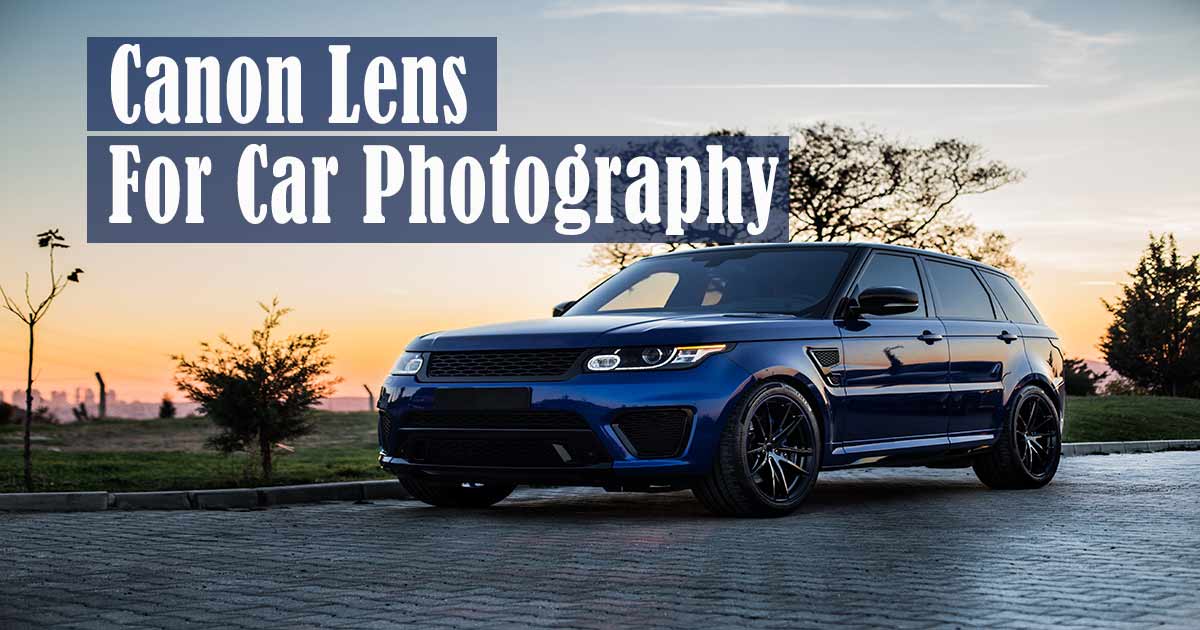The best Canon lens for car photography in 2026 includes a range of shooting static shots, motion, rolling shots, interior details, and creative aspects in various scenarios. As an automotive photographer, your job is to highlight every vehicle detail that car enthusiasts truly appreciate – the design, details, style, and features, taking into account factors such as composition, lighting, and angles.
While no single lens can capture every type of automotive shot, selecting the right ones can significantly enhance your car photography results. The 7 Best Canon Lenses for Car Photography include Canon EF-S 24mm f/2.8 STM, Canon EF 28mm f/2.8 IS USM, Canon EF 50mm f/1.4 USM Lens, Canon EF 24-70mm f/2.8L II USM, Canon EF 100-400mm f/4.5-5.6L IS II, Canon EF 85mm f/1.8 USM, and Canon EF 70-200mm f/2.8L IS II USM. Below, we’ve highlighted key features of our best Canon lenses that ease your purchase process:
1. Canon EF-S 24mm f/2.8 STM: A compact and lightweight prime lens ideal for wide-angle shots of cars in tight spaces or dynamic street scenes.
2. Canon EF 28mm f/2.8 IS USM: Offers sharpness and image stabilization, making it great for handheld wide-angle car photography with minimal distortion.
3. Canon EF 50mm f/1.4 USM Lens: Known for its beautiful bokeh and sharp detail, this lens is excellent for capturing portraits of cars with blurred backgrounds.
4. Canon EF 24-70mm f/2.8L II USM: A highly versatile zoom lens that can cover a range of focal lengths, perfect for shooting cars in different environments and compositions.
5. Canon EF 100-400mm f/4.5-5.6L IS II: An ideal choice for capturing cars in motion at races or events, this lens offers excellent reach and sharp image quality.
6. Canon EF 85mm f/1.8 USM: Perfect for isolating details or shooting car portraits, this prime lens delivers crisp images and smooth background blur.
7. Canon EF 70-200mm f/2.8L IS II USM: A staple in automotive photography, this lens offers superb image quality and flexibility for shooting both static and moving cars.
What you’ll learn in this article
- 1 1. Canon EF-S 24mm f/2.8 STM
- 2 2. Canon EF 28mm f/2.8 IS USM
- 3 3. Canon EF 50mm f/1.4 USM Lens
- 4 4. Canon EF 24-70mm f/2.8L II USM
- 5 5. Canon EF 100-400mm f/4.5-5.6L IS II
- 6 6. Canon EF 85mm f/1.8 USM
- 7 7. Canon EF 70-200mm f/2.8L IS II USM
- 8 Which Types of Lenses are Best for Car Photography?
- 9 Why Does Choosing the Best Lens for Car Photography Matter?
1. Canon EF-S 24mm f/2.8 STM
This wide-angle pancake lens has ranked 1st in our list of Canon’s best lenses for car photography. It’s a small-sized prime lens and is specifically compatible with DSLR cameras with APS-C sensors.
The thin structure is quite handy for outdoor shooting when you are capturing wide-angle images. As cars are your model, you can take shots of streetcars, giant cars with background detail, cars in the widest field view, or in low-light situations, which are good-to-go shots for you.
Key Specifications
Dimension: 0.91 x 2.68 x 2.68 inches
Weight: 4.4 ounces
Lens construction: 6 elements in 5 groups
Diagonal angle of view: 59°10′
Closest Focusing Distance: 0.52 ft. / 0.16 m
| Pros | Cons |
| Sharp image quality | Doesn’t have image stabilization |
| Lightweight and compact | |
| Quick to focus |
2. Canon EF 28mm f/2.8 IS USM
This is a wide-angle full-frame lens. It is a prime lens as it doesn’t allow zooming in/out. With the sturdy building and ring-type USM motor inside, it is fast, accurate, and automatic to focus on the subject and offers enhanced quality images.
For your search for the canon best lens for car photography, this lens can add bang for your buck by allowing vibrant color images with a wide background and sharp photos. In short, you can take shots of a car entirely without any unwanted situations.
Key Specifications
Dimension: 2.2 x 2.68 x 2.68 inches
Weight: 9.9 ounces
Lens construction: 11 elements in 9 groups
Diagonal angle of view: 84 degrees
Close-up focus distance: 0.25m/0.82 ft
| Pros | Cros |
| Stabilize images (no blurry photos) | Not good for shooting videos as the motor inside creates noise. |
| Convenient to work in low light |
3. Canon EF 50mm f/1.4 USM Lens
This is a telephoto lens and is perfectly suitable for daily shooting. With this lens in hand, you can shoot vivid photos in low light and shallow depth of field. However, in strong light, it doesn’t create ghosting or flare.
Just like the previous one, having the USM motor as an in-built feature, this lens is quick to focus. It allows users to capture images with a soft blurring effect without any distortion. If you are to shoot a video, an adjoining tripod will give you the best output.
Key Specifications
Dimension: 2.01 x 2.91 x 2.91 inches
Weight: 10.2 ounces
Lens construction: 7 elements in 6 groups
Angle of view: 46 degrees
Closest focusing distance: 1.5 feet
| Pros | Cons |
| Lightweight building | Lacks weather resistance |
| Video shooting in low light |
4. Canon EF 24-70mm f/2.8L II USM
This is another best lenses for car photography by Canon. It is a full-frame rotatable standard zoom lens. Whether cars are still or in motion, this lens allows users to take sharp and high-quality images with maximum speed and accuracy.
It is strongly built and tiny in size. The design follows the typical L series of Canon lenses. It allows fast focus and accurate images that are propelled by the inside USM lens.
Key Specifications
Dimension: 4.45 x 3.5 x 3.5 inches
Weight: 1.77 pounds
Lens construction: 18 elements in 13 groups
Diagonal angle of view: 84° – 34°
Close focusing distance: 0.38m/1.25 ft
| Pros | Cons |
| Offers outstanding optical performance | Doesn’t have image stabilization |
| Produces sharp and high-quality images | Expensive |
| Controls chromatic aberrations, distortions |
5. Canon EF 100-400mm f/4.5-5.6L IS II
Here’s our next L-series Canon lens for car photography. It is a telephoto zoom lens that allows users to take high-quality shots from a distance. The rotation-style zoom ring inside ensures image precision when it is used for shooting moving subjects.
Canon has incorporated an enhanced optical design, improved image stabilization, weather resistance capability, and many other features in this lens, making it one of the best lenses for shooting distant subjects.
Key Specifications
Dimension: 7.6 x 3.7 x 3.7 inches
Weight: 3.46 pounds
Lens construction: 21 elements in 16 groups
Diagonal angle of view: 24°–6°10′
Close focusing distance: 3.2 ft. / 0.98m
| Pros | Cons |
| Takes sharp shots from afar | A bit weighty |
| Impressive image quality | |
| Quality bokeh effect | |
| Perfect for shooting race track cars |
6. Canon EF 85mm f/1.8 USM
Canon EF 85mm f/1.8 USM is one of the best camera lenses for car photography. This is a telephoto lens and works awesome in any lighting, especially in low-light situations- a great deal in exchange for bucks.
The lens is lightweight, small-sized, and provides fast results due to the USM inside. It is widely popular for optical quality and sustainability. It gets close to the subject and ensures sharp results.
Key Specifications
Dimension: 2.83 x 2.95 x 2.95 inches
Weight: 15 ounces
Lens construction: 9 elements in 7 groups
Diagonal angle of view: 28.5 degrees
Close focusing distance: 2.8 feet
| Pros | Cons |
| Works fine in low light | a fixed lens |
| Satisfactory quality and results | Doesn’t have image stabilization |
| Fantastic DOF and amazing bokeh | |
| Sharp and vibrant images |
7. Canon EF 70-200mm f/2.8L IS II USM
This is the last one of our canon best lenses for car photography. It is another telephoto zoom lens that delivers outstanding results. This L-series lens of Canon has a sturdy build. It is weather-resistant, so taking shots from afar or zooming in fast and smoothly is way easier.
The offered image quality is mind-blowing, and it focuses accurately. It has an in-built chromatic aberration mechanism. Also, it allows detailed shooting of the subject with a beautifully blurred background.
Key Specifications
Dimension: 7.8 x 3.5 x 3.5 inches
Weight: 3.18 pounds
Lens construction: 23 elements, 19 groups
Diagonal angle of view: 34° – 12°
Close focusing distance: 3.9 feet, 1.2 meters
| Pros | Cons |
| Fast autofocus | Heavy weighted |
| Dust and water-resistant | |
| ns flare and shake reduction |
Things to Consider While Buying the Best Lens for Car Photography
A camera lens is the type of gear that will benefit you for a long time if it’s the right fit. Therefore, choosing it with caution is a must.
Also Read: What is the Best Camera for Food Photography
Which Types of Lenses are Best for Car Photography?
Every subject glows under the right lens functionality, and that will differ from product to product. A lens that shoots a giant car may not be a wise choice to shoot the rear-view mirror or the paddle shifters.
Here, we have listed down the 4 best lenses that are proven to do justice for car photography. Those are-
- Wide-angle lens
- Zoom lens
- Prime lens
- Telephoto lens
1. Wide-Angle Lens
A wide-angle lens captures images of a wide area. It has a short focal length maximum of 35mm. When you need to shoot a car with details in the background (i.e., internal parts of a car), a wide lens should be your 1st pick.
This lens allows you to take close shots, including the vital elements inside the frame. As a result, you will get images that will show a real look as you see with your bare eyes.
If you are to shoot a small area, this lens works best as well. In the case of a bigger area, no matter what elements are included in your frame, everything near and far will be focused sharply.
2. Zoom Lens
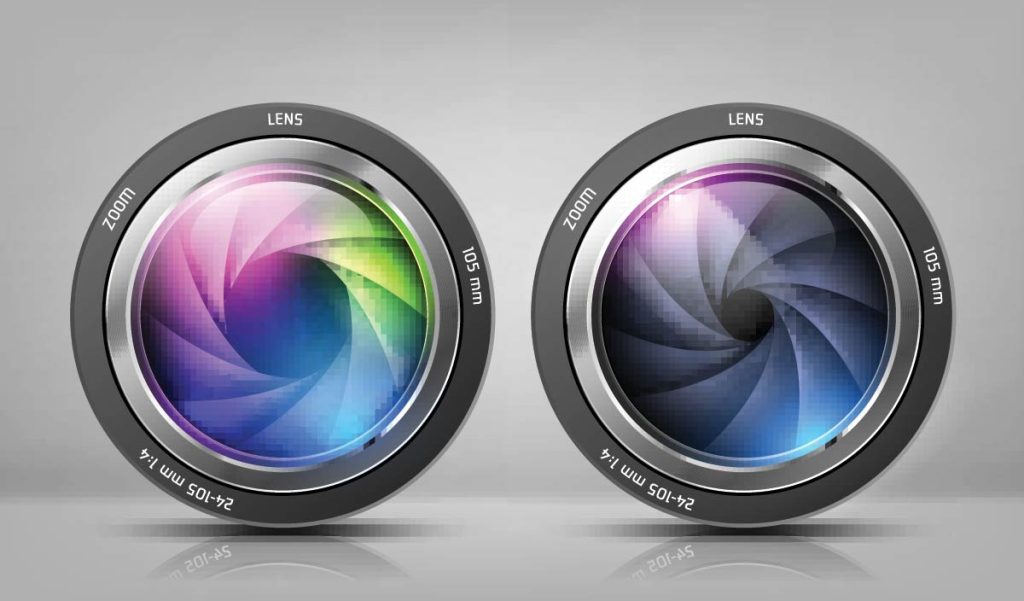
A zoom lens is a single lens that has different focal lengths. It has different variables that allow users to make the scene in the frame zoom in or zoom out.
A zoom lens generally has a different focal length, which ranges between 2 numbers. For example, a 70-200mm lens allows you to zoom up to 70mm. The magnification level of the zoom lens allows you to cut out the unwanted parts and sharply focus on the subject.
As there are adjustable focal lengths, you can shoot cars at maximum resolution. You don’t even have to change lenses or think about the camera. This is a great option for car shooting outside as it saves you from carrying multiple lenses.
3. Prime Lens
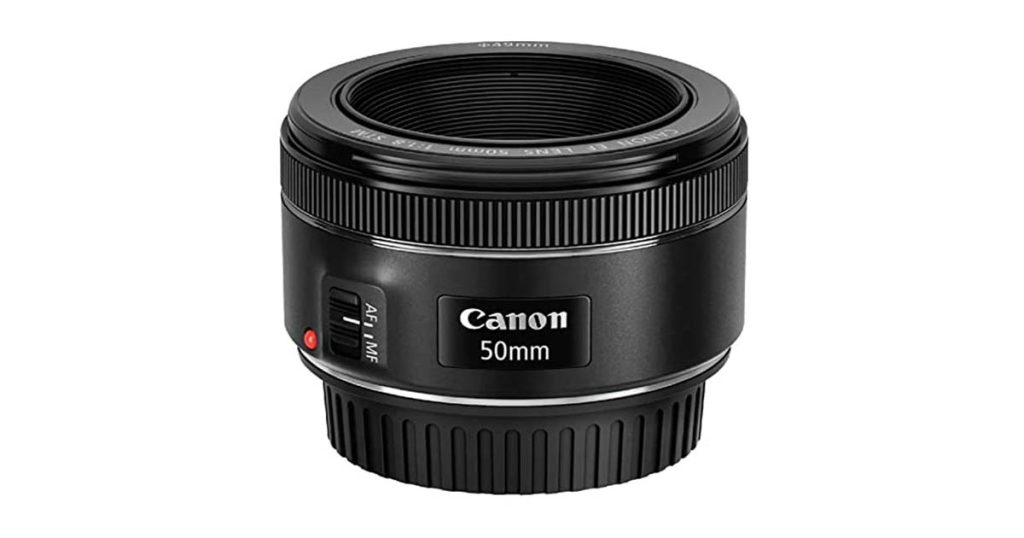
A prime has a fixed focal length, for example, 50mm. It means you can neither zoom in nor zoom out. Also, you don’t have to deal with distortion issues.
Rather, with a wide aperture, it allows more light to enter, resulting in shooting well in low light. Also, this lens is known for taking high-quality, sharp images, and thus, it can be a good choice for car photography.
If you want shots where your car will look super sharp, but your background will remain blurred, a prime lens is a perfect lens. It’s one of the preferred lenses by professional photographers for light in weight, small in size, easier to cope with, and producing quality images.
4. Telephoto Lens
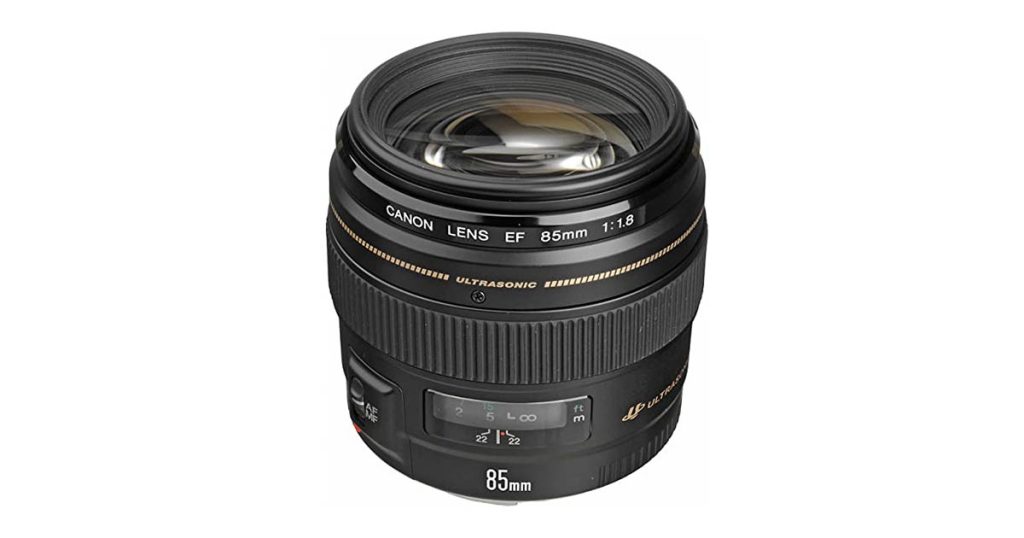
A telephoto lens can vary; it can be a zoom lens or a prime lens. However, a normal telephoto lens has a focal length of a minimum of 70mm.
This lens has a narrow field of view, meaning this can take shots of an object at a certain distance. Even if the subject is small in size, the lens makes it appear closer and bigger. Also, it makes the background blur, thus separating the subject so that viewers get to focus only on the subject.
Telephoto lenses are used when the subject is unreachable. Hence, you can use this lens for taking shots of cars in motion. Being somewhat heavy-weight, it needs a tripod to support it.
Also Read: 35mm vs 50mm vs 85mm: Which Lens is Best for Portraits?
What Makes a Lens Best for Car Photography?
No lens won’t work for taking car shots. Some lenses do best here. It depends on the features that comply well with a camera to bring the best version of car images.
Do You Need a Special Lens to Photograph Moving Cars?
Yes, you do. You can use a telephoto or zoom lens for taking shots of moving cars.
Why Does Choosing the Best Lens for Car Photography Matter?
The best lens does a lot more than just shooting cars. Choosing the best lens for car photography is important because it
- Minimizes chromatic aberration, distortion, or vignetting.
- Offers a wide variety of aperture ranges that are crucial for night or low-light situations.
- Captures a wide scene of cars, including foreground and background details.
- Creates layers in the composition.
- Offers a polarizing filter to reduce unwanted reflection from the car photos.
- Offers a variety of faster shutter speed ranges to avoid blur when shooting a racing car.
What Factors to Consider While Choosing the Best Lenses for Car Photography?
1. Zoom or Prime Lens
If you need to shoot your car with a fast reframing option, a zoom lens will give you that type of accessibility. But, if you need quality images without thinking of zooming, a prime lens will do the job.
2. Image Stabilization
It helps to create sharp images by decreasing blur; in short, it makes images stable and clear. Most cameras have this system inbuilt; if not, you should buy an in-body stabilization lens.
Lens manufacturers name image stabilization differently, such as –
| Brand | Abbreviation | Extension |
|---|---|---|
| Canon | IS | Image Stabilization |
| Panasonic, Fujifilm | OIS | Optical Image Stabilization |
| Nikon | VR | Vibration Reduction |
| Sony | OSS | Optical Steady Shot |
| Tamron | VC | Vibration Control |
| Sigma | OS | Optical Stabilization |
3. Aperture Range
The aperture is the lens opening through which light transmits. The lens’ barrel has the range of aperture written in the word “F/f”. The smaller (i.e., f/22), the wider scene a lens captures, and vice versa.
4. Focus Options
For fast and quick action, autofocusing lenses are popular and available now. Most lenses allow switching between auto and manual, though. However, an autofocus lens tends to be somewhat pricey, but worth it.
5. Focal Length
Focal length is expressed in millimeters (mm). Every camera has a focal length number imprinted on its body. The bigger the number, the less scene it captures, and the smaller the numbers, the wider the details will be included.
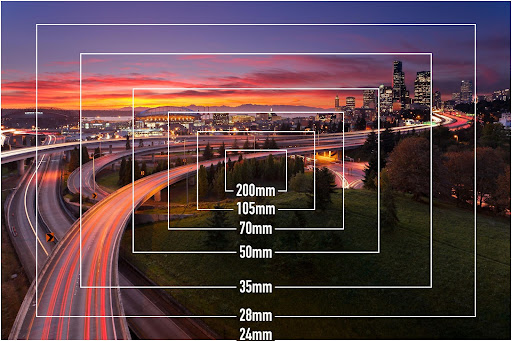
Source: DPreview
6. Camera Compatibility
For an APS-C (cropped sensor size) camera, both APS-C and full-frame lenses will be compatible. But for a full-frame sensor camera, you must use a full-frame lens. General lenses are built targeting full-frame cameras.
7. Weight and Size
Lens’ weight and size matter a lot. No matter which lens you choose to pick, after frequently using that, these won’t bother you much. But if you have to use telephoto lenses, weight is something you can’t shake off.
8. Durability
Shooting in different weather might get you an exquisite level of car images. Hence, make sure to pick a weather-resistant lens. Such a lens has an inbuilt structure that prevents dust or water from penetrating inside and makes it safe to work.
9. Budget
Having a lavish budget may get you a good lens, but if you are on a tight budget, you may have to search hard. If you are new to car photography, buying a pre-owned one is suggested. After you have done your fair share of research, make sure to check the reviews of other users. It will give you extra advantages and make sorting out your car photography lens easier.
